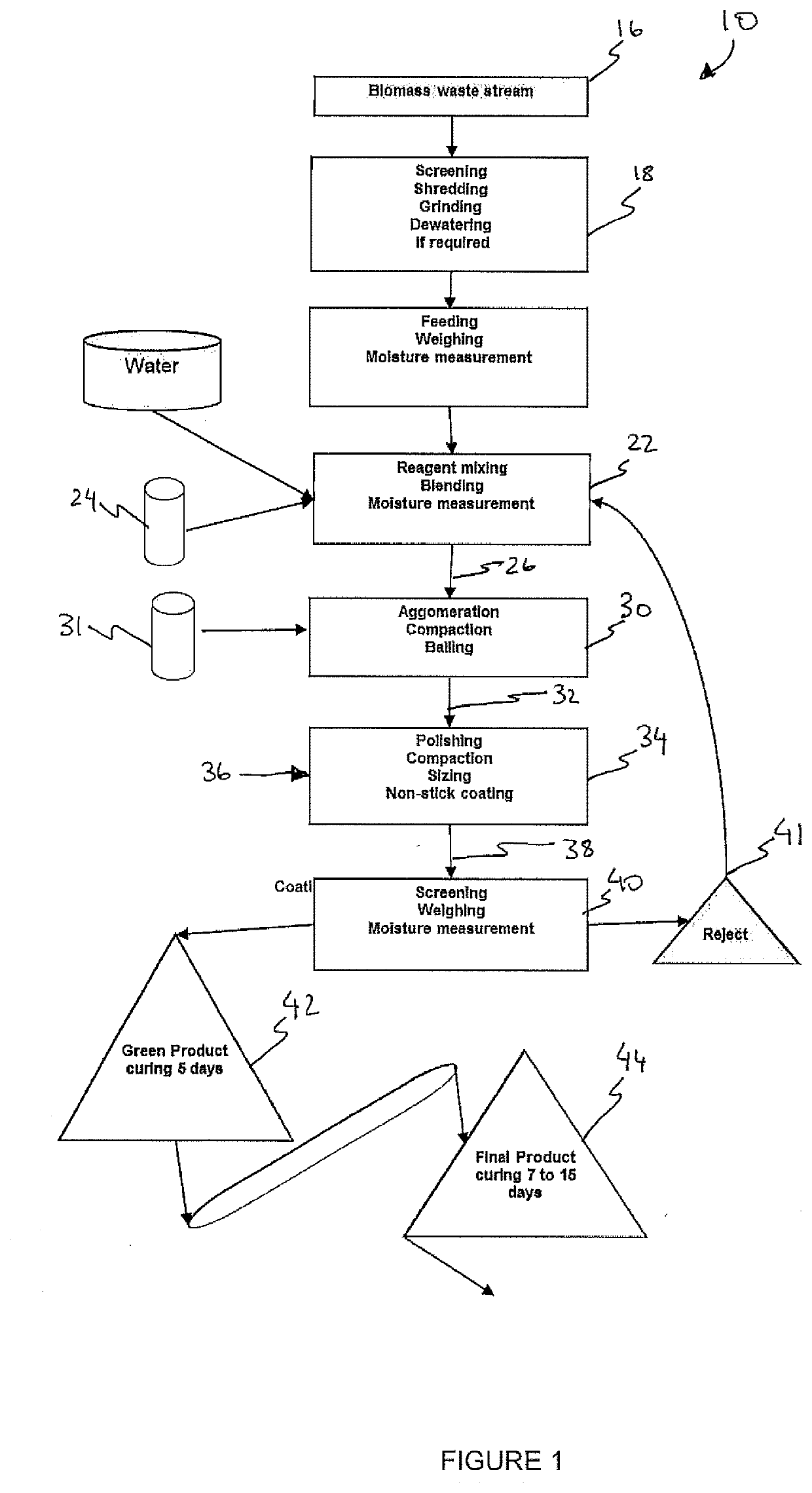Method for Producing Agglomerates from a Biomass Stream
a technology of biomass stream and agglomerate, which is applied in the direction of biofuels, waste based fuels, fuels, etc., can solve the problems of reducing the energy required for evaporation of water from the agglomerate, and achieves the effects of reducing the amount of agglomerate, and reducing the energy required for evaporation
- Summary
- Abstract
- Description
- Claims
- Application Information
AI Technical Summary
Benefits of technology
Problems solved by technology
Method used
Image
Examples
example 1
[0091]Agglomerates suitable for use as a fuel source were prepared using Cellulosic Lignin waste sourced from Cresentino Cellulosic Ethanol plant, Italy as an organic feedstock.
[0092]The binder reagent used was a styrene acrylic emulsion.
[0093]The polymerisation activator was diethylene glycol in the presence of an ammonium persulphate initiator reagent.
DryWetCalculatedCalculatedMaterialWeight gWeight gWater (g)Solids %Lignin sludge3,3089,450Total dry feed3,308Reagent liquid used50Binder reagent used dry12.40Binder waterWater trim added0Total weights3,3209,5006,18034.95ResultsWeight gGreen pellets produced9,466Drum losses34Pellets size range15-25 mmDesiccating ConditionsTray stored open top - still airNo fan ventilationNo air conditioningAmbient Conditions during desiccation - Max / MinMax TempMin TempTime(° C.)(° C.)Humidity - reportedDay282770% to 78%Night181763% to 65%MoistureTotal Water% ofSolidsDayWeightLoss (g / d)Loss (g)wet%09,466018,9015655655.9737.3028,3505511,11611.7939.7637,...
example 2
[0094]Agglomerates suitable for use as a fuel source were prepared using Cellulosic Lignin waste sourced from a Korean R&D laboratory in Seoul, Korea as an organic feedstock.
[0095]The binder reagent used was a styrene acrylic emulsion.
[0096]The polymerisation activator was diethylene glycol in the presence of an ammonium persulphate initiator reagent.
DryWetCalculatedCalculatedData for Run #3Weight gWeight gWater (g)Solids %Lignin sludge2,4706,500Total dry feed2,470Reagent liquid used37Binder reagent used dry9.26Binder waterWater trim added0Total weights2,4796,5374,05837.93ResultsWeight gGreen pellets produced6,505Drum losses32Pellets size range10-15 mmDesiccating ConditionsTray stored open top - still airNo fan ventilationNo air conditioningAmbient Conditions during desiccation - Max / MinTimeMax Temp (° C.)Min Temp (° C.)Humidity - reportedDay343170% to 78%Night232063% to 65%MoistureTotal Water% ofSolidsDayWeightLoss (g / d)Loss (g)wet%06,505016,1024034036.2040.6325,74435876111.7043.16...
example 3
[0097]Agglomerates suitable for use as a fuel source were prepared using chicken litter sourced from the University of Queensland and the University of Southern Queensland as an organic feedstock.
[0098]The binder reagent used was a methoxysilane solution.
[0099]The polymerisation activator was diethylene glycol in the presence of an ammonium persulphate initiator reagent.
DryWetCalculatedCalculatedData for Run #3Weight gWeight gWater (g)Solids %Chicken Litter3,8258,500Total dry feed3,825Reagent liquid used46Binder reagent used dry11.48Binder waterWater trim added0Total weights3,8368,5464,70944.89ResultsWeight gGreen pellets produced8,522Drum losses24Pellets size range10-15 mmDesiccating ConditionsTray stored open top - still airNo fan ventilationNo air conditioningAmbient Conditions during desiccation - Max / MinMax TempMin TempTime(° C.)(° C.)Humidity - reportedDay242065% to 72%Night151252% to 56%MoistureTotal Water% ofSolidsDayWeightLoss (g / d)Loss (g)wet%08,522018,0065165166.0547.9227...
PUM
 Login to View More
Login to View More Abstract
Description
Claims
Application Information
 Login to View More
Login to View More - R&D
- Intellectual Property
- Life Sciences
- Materials
- Tech Scout
- Unparalleled Data Quality
- Higher Quality Content
- 60% Fewer Hallucinations
Browse by: Latest US Patents, China's latest patents, Technical Efficacy Thesaurus, Application Domain, Technology Topic, Popular Technical Reports.
© 2025 PatSnap. All rights reserved.Legal|Privacy policy|Modern Slavery Act Transparency Statement|Sitemap|About US| Contact US: help@patsnap.com

